#Political movement
Explore tagged Tumblr posts
Text
The history of Solarpunk

Okay, I guess this has to be said, because the people will always claim the same wrong thing: No, Solarpunk did not "start out as an aesthetic". Jesus, where the hell does this claim even come from? Like, honestly, I am asking.
Solarpunk started out as a genre, that yes, did also include design elements, but also literary elements. A vaguely defined literary genre, but a genre never the less.
And I am not even talking about those early books that we today also claim under the Solarpunk umbrella. So, no, I am not talking about Ursula K. LeGuin, even though she definitely was a big influence on the genre.
The actual history of Solarpunk goes something like that: In the late 1990s and early 2000s the term "Ecopunk" was coined, which was used to refer to books that kinda fit into the Cyberpunk genre umbrella, but were more focused on ecological themes. This was less focused on the "high tech, high life" mantra that Solarpunk ended up with, but it was SciFi stories, that were focused on people interacting with the environment. Often set to a backdrop of environmental apocalypse. Now, other than Solarpunk just a bit later, this genre never got that well defined (especially with Solarpunk kinda taking over the role). As such there is only a handful of things that ever officially called themselves Ecopunk.
At the same time, though, the same sort of thought was picked up in the Brazilian science fiction scene, where the idea was further developed. Both artistically, where it got a lot of influence from the Amazofuturism movement, but also as an ideology. In this there were the ideas from Ecopunk as the "scifi in the ecological collaps" in there, but also the idea of "scifi with technology that allows us to live within the changing world/allows us to live more in harmony with nature".
Now, we do not really know who came up with the idea of naming this "Solarpunk". From all I can find the earliest mention of the term "Solarpunk" that is still online today is in this article from the Blog Republic of Bees. But given the way the blogger talks about it, it is clear there was some vague definition of the genre before it.
These days it is kinda argued about whether that title originally arose in Brazil or in the Anglosphere. But it seems very likely that the term was coined between 2006 and 2008, coming either out of the Brazilian movement around Ecopunk or out of the English Steampunk movement (specifically the literary branch of the Steampunk genre).
In the following years it was thrown around for a bit (there is an archived Wired article from 2009, that mentions the term once, as well as one other article), but for the moment there was not a lot happening in this regard.
Until 2012, when the Brazilian Solarpunk movement really started to bloom and at the same time in Italy Commando Jugendstil made their appearance. In 2012 in Brazil the anthology "Solarpunk: Histórias ecológicas e fantásticas em um mundo sustentável" was released (that did get an English translation not too long ago) establishing some groundwork for the genre. And Commando Jugendstil, who describe themselves as both a "Communication Project" and an "Art Movement", started to work on Solarpunk in Italy. Now, Commando Jugendstil is a bit more complicated than just one or the other. As they very much were a big influence on some of the aesthetic concepts, but also were releasing short stories and did some actual punky political action within Italy.
And all of that was happening in 2012, where the term really started to take off.
And only after this, in 2014, Solarpunk became this aesthetic we know today, when a (now defuct) tumblr blog started posting photos, artworks and other aesthetical things under the caption of Solarpunk. Especially as it was the first time the term was widely used within the Anglosphere.
Undoubtedly: This was probably how most people first learned of Solarpunk... But it was not how Solarpunk started. So, please stop spreading that myth.
The reason this bothers me so much is, that it so widely ignores how this movement definitely has its roots within Latin America and specifically Brazil. Instead this myth basically tries to claim Solarpunk as a thing that fully and completely originated within the anglosphere. Which is just is not.
And yes, there was artistic aspects to that early Solarpunk movement, too. But also a literary and political aspectt. That is not something that was put onto a term that was originally an aesthetic - but rather it was something that was there from the very beginning.
Again: There has been an artistic and aesthetic aspect in Solarpunk from the very beginning, yes. But there has been a literary and political aspect in it the entire time, too. And trying to divorce Solarpunk from those things is just wrong and also... kinda misses the point.
So, please. Just stop claiming that entire "it has been an aesthetic first" thing. Solarpunk is a genre of fiction, it is a political movement, just as much as it is an artistic movement. Always has been. And there has always been punk in it. So, please, stop acting as if Solarpunk is just "pretty artistic vibes". It is not.
Thanks for coming to my TED Talk, I guess.

#solarpunk#solarpunk aesthetic#solarpunk fiction#political movement#history#history of solarpunk#amazofuturismus#put the punk back in solarpunk#scifi#science fiction#clifi#climate fiction#ecopunk
3K notes
·
View notes
Text
Quidditism


The quidditism movement seeks to take peaceful action to push the world towards a more accepting, tolerant and peaceful future. where all beings can thrive without fear.
Other appelations: existential progressivism, existential punk, exipunk, existance
Values at a glance
Radical Inclusionism
Anarchy
Punk
Transhumanism
Existentialism
Realmism
Progressivism
Limited Contact
Anti-censorship
Why quidditism?
Here is the definition of quiddity. This movement focuses on the simple fact that existing and living should be a given for everyone, no matter their particularities. Notice how both of 'quiddity''s definitions relate to that? That's why!
Flag Meaning

In more detail:
Radical inclusion, as it is one of the core values of the movement.
MOGAI, which includes all identities comprised under LGBTQIA+ (gay, lesban, bi, pan, aspec IDs, transidentity (which in itself includes two-spirit, nonbinary, genderfluidity,...), along with neo/xenoIDs (genders, identities, sexuality, agabs, malady,...), alterhumanity (including misceverse, fictionkin, factkin, otherkinks, funlinks, copinglinks, otherhearteds, theiantropy, non-humanity, voidpunk, lycantropy,...) and intersex beings.
The intersex flag's yellow was added to put more emphasis on that part of the community.
TransIDs, including other identioras like dissomeis, disconomeis and intusuis.
The black and brown stripes represent BIPOC (aka black, indigenous and people of color).
The pink stripe represents sexual liberation. That includes sexual education, sex workers' rights, the destigmatisation of kinks, paraphilias and fetishes, and the importance of consent.
The red stripe represents life. in terms of surviving first, but also in terms of thriving, because everyone deserves to exist and enjoy life.
The orange stripe represents healing. that includes the choice to recover or not, the full understanding of any procedures, full body autonomy, destigmatisation of body modification, and available resources for recovery, harm reduction, and all options available.
The green and yellow stripes represent nature and ecology. Nature is our home, and we need to care for it.
The teal stripe represents all art, and being anti-censorship.
The indigo stripe represents solidarity. In all of our differences, we have to stand together and take care of each other for any society to flourish.
The magenta stripes represents the mind, the spirit. It includes all religions and all faiths and spirituality, including neoreligions. It also stands for neurodiversity, and the knowledge that everybody works and functions differently.
Resources
���� Discord Server
#existential progressivism#existetial progressive#existential punk#quidditism#exipunk#existance#politics#political movement#pro rqc#pro rq 🌈🍓#pro para#pro transx#pro transid#fleur community#political ideology#ideology#activism#rq community#paraphile safe#rad inclus#rq interact#blankqueer#blankstance
7 notes
·
View notes
Text
Jewish Anarchism Flag
PT: Jewish Anarchism Flag /end PT

ID: a completely black flag with in the center a white symbol composed of a circle with the Hebrew Aleph inside. The Hebrew letter Aleph consists of a diagonal line that connects two horizontal lines at the top and bottom. The upper line is slightly longer than the lower line, creating a shape that resembles a stylized X with a vertical line through the middle. END ID
Jewish anarchism: a political movement that combines elements of anarchism with Jewish thought and culture. It advocates for a society without hierarchical structures or centralized authority, emphasizing individual freedom, mutual aid, and community cooperation. Jewish anarchists often draw on Jewish traditions, texts, and values to support their beliefs in social justice, equality, and critique of oppressive systems.
No know creator for the design since it is a widely used one since years.
Edited 30 to correct wrong credits.
#Jewish#Judaism#ethnoreligious group#political movement#anarchy#anarchist#anarchism#anarchopunk#Jewish anarchism#anarcho Judaism#combo flag#intersectionality#cultural identity#bipoc#indiqueer#Jewblr#ethnoracialized group#Jumblr
13 notes
·
View notes
Text
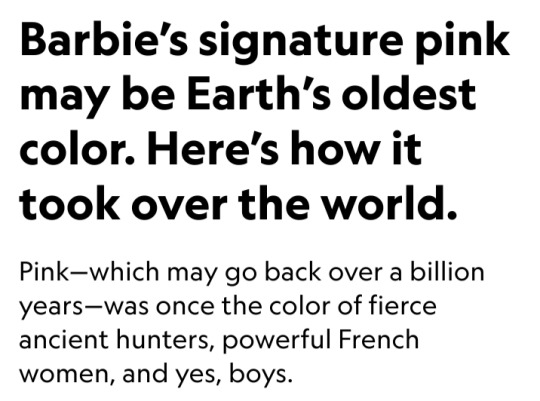

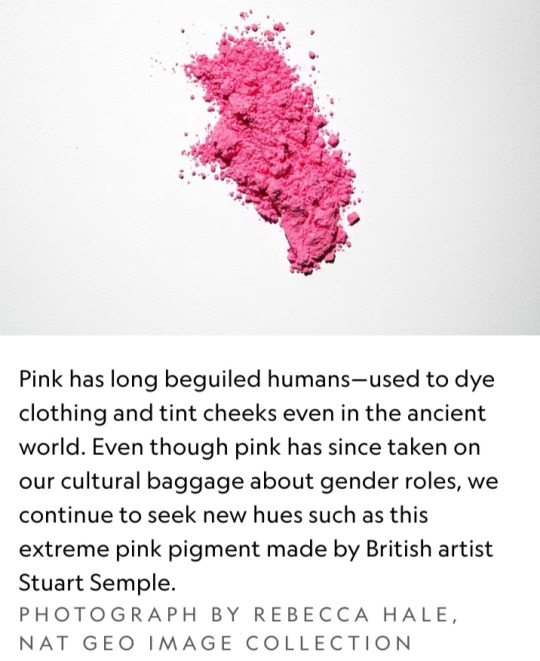
Could pink be Earth’s oldest color? That’s the implication of a 2018 study that found bright-pink pigments in 1.1 billion-year-old rocks — thanks to the fossils of the billions of tiny cyanobacteria that once dominated oceans.
The natural world has long been painted with every permutation of pink — whether embedded deep in ancient rock, sported by shrimp-hungry flamingoes, or simply lining the shores of Bermuda’s pink-sand beaches.
And yet the color carries a lot of cultural baggage.
As pink made the jump from nature’s palette to human adornment, it gathered connotations of colonialism, beauty, power, and gender.
How did pink become such a cultural flashpoint? As the world takes a revitalized interest in the hot-pink planet inhabited by Barbie, here’s a short history of the compelling color.
Admiration for pink in the ancient world
Early humans quickly transitioned from admiring pink in the natural world to attempting to wear it.
For example, in the Andes Mountains about 9,000 years ago, fierce hunters in what is now Peru wore tailored leather clothing with a pink hue thanks to red ochre, an iron oxide pigment that is one of the oldest natural pigments used by humans.
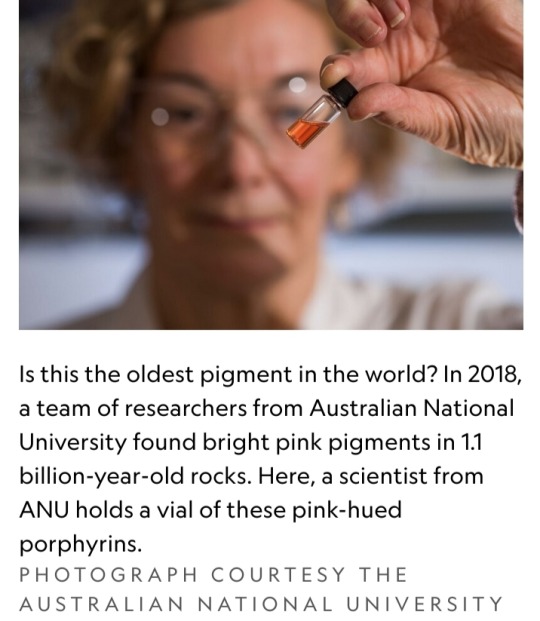
Humans weren’t content just to smear this pigment on cave walls or use it while tanning their leather garments.
As far back as ancient Egypt, humans used ochre to tint their lips and cheeks.
When applied to human skin, the red pigment created a blush-like pink that onlookers associated with love, sexuality, and beauty.
Lookalike concoctions prevailed around the world, employing everything from crushed strawberries to red amaranth.
The color of cosmetics—and colonialism
Though the word’s etymology is unknown, the word “pink” was used to describe the color in the 18th century.
By then, pink had become inextricably tied with colonialism — as demand for the pigment for cosmetics drove Europeans to harvest natural resources in other parts of the world.
For example, in a bid to make pinkish pigments from the bark and red sap of brazilwood trees, European traders forced enslaved workers to cut down so many of Brazil’s eponymous trees that the country was left deforested and the tree nearly driven extinct.

During this Era of Exploration, consumers also got their pink cheeks and lips from other pigments like carmine, derived from cochineal insects harvested in Central and South America under similar conditions.
Meanwhile, the color also had a more literal association with colonialism:
During this time, the British Empire grew so massive that the color pink — which mapmakers used to mark its territories worldwide — dominated the world map.
Pink becomes a bona fide fashion craze
As red tints became more accessible and cheaper, 18th-century European aristocrats indulged a passion for pink.
Art historian Michel Pastoureau writes that “the most privileged classes of European society wanted pastels, halftones, and the newest innovations in color shades in order to distinguish themselves from the middle classes, who now had access to bright, strong, and reliable colors.”
Madame de Pompadour, the mistress of Louis XV of France during the 1740s and 1750s, used the color as a signature.
The artists who painted her and created fine objects for her many homes used pink in all their designs, even her carriages, and she helped further popularize the hue throughout Europe.
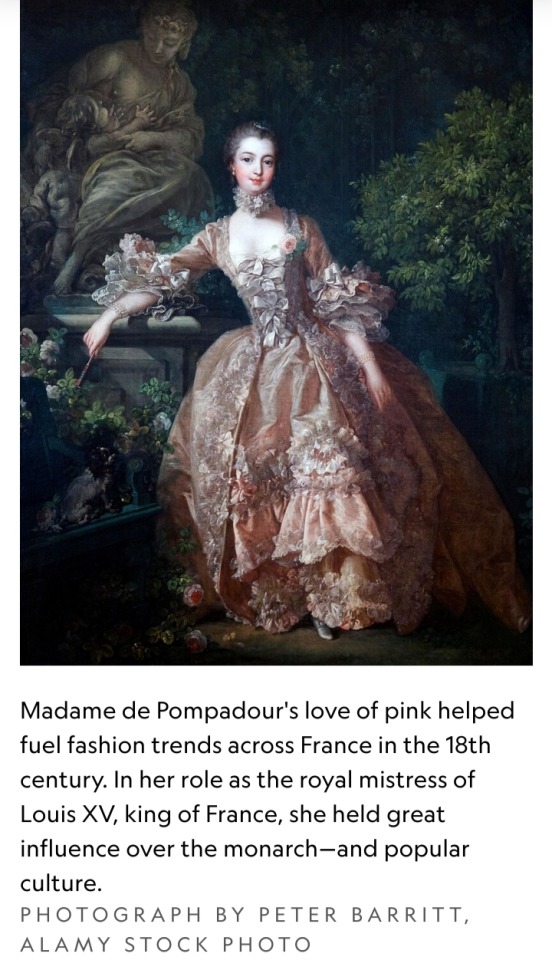
The emergence of synthetic dyes in the mid-19th century — which gave rise to the purple-pink color known as mauve — made pink more accessible than ever before.
By the 1930s, bright pink had become a bona fide fashion craze.
Avant-garde fashion designer Elsa Schiaparelli made “shocking pink” her signature color, helping spread the vogue for women’s wear.
It worked: By 1935, even local newspapers like the News and Observer in Raleigh, North Carolina, were declaring that “PINK IS FAVORITE.”
And in 1939, a royal commentator wrote in London’s Daily Telegraph that pink was so popular, it was nearly ubiquitous for both bridesmaids and debutantes.
“So general is the pink craze,” the paper wrote, “that some women are rebelling against it.”
Pink is for…boys?
Around the same time, pink gained relevance in another realm: baby fashion.
Gender and baby fashion had intersected for years; around World War I, etiquette guides and fashion advice columns began advising that mothers dress their children in clothing with gender-specific hues.
But which colors? A 1927 retailer survey on infant clothing colors published in TIME shows a split nation, with retailers like Filene’s and Marshall Field’s recommending pink for boys, but Macy’s, Bullock’s, and others claiming pink was best for girls.
By the 1960s, however, mothers began buying pink clothing for their female babies, dressing their male children in pastel blues.
“None of this transition happened by childcare expert fiat or industry proclamation,” writes historian Jo B. Paoletti.
Instead, pink gained steam as a signifier of a baby’s female sex as part of a post-World War II push to reinforce traditional gender roles in American homes — and the realization by retailers that they could make more money that way.
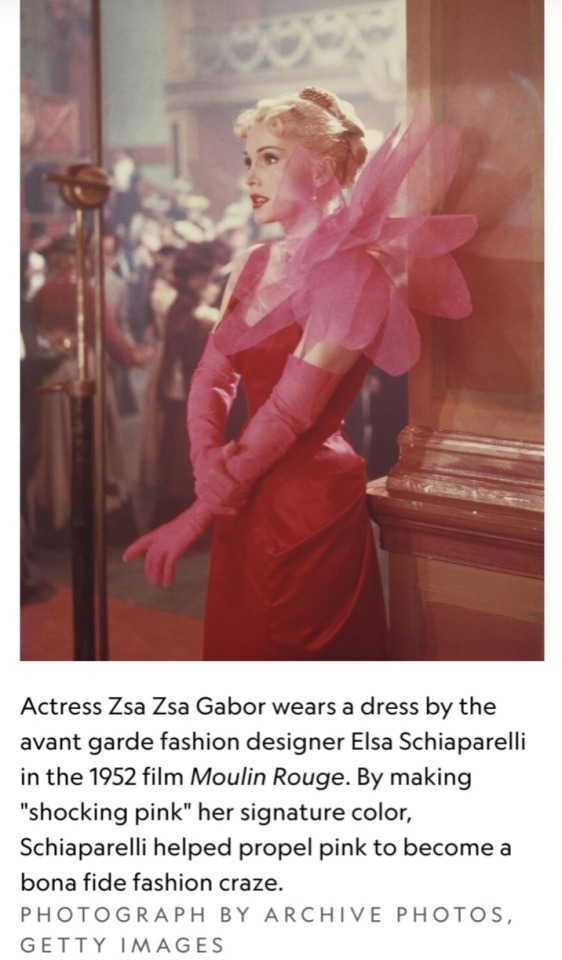
“The more baby clothing could be designed for an individual child — and sex was the easiest and most obvious way to distinguish babies — the harder it would be for parents to hand down clothing from one child to the next, and the more clothing they would have to buy as their family grew,” Paoletti writes.
Soon, retailers featured entire “pink aisles” packed with pink-colored clothing and toys for tiny consumers.
The dark side of pink
Pink was also rejected by some as a symbol of weakness or even sinister intent.
In Nazi Germany, for example, the color was used to brand gay men in concentration and death camps.
As the Cold War emerged, suspected Communist sympathizers were given the derogatory name of “pinkos” — a term that referred to a person with “red” tendencies toward radical politics.
Meanwhile, members of the women’s liberation movement attempted to distance themselves from a color that had become inextricably linked with femininity and sexuality — think: Marilyn Monroe slinking down a staircase in a shocking pink gown, surrounded by tuxedoed men.
Anti-feminists, meanwhile, embraced pink.
Author Helen B. Andelin, for example, made public appearances in all-pink ensembles in the 1960s and 1970s during lectures encouraging women to abandon feminism and embrace lives as housewives.
Reclaiming pink
Pink remains associated with femininity to this day — but in recent decades, groups once disdainfully branded with the color have made moves to reclaim it.
In the LGBTQ community, for example, people who were once forced to wear pink as outcasts have adopted the hue as a symbol of their movement for social justice.
In 1987, the AIDS Coalition to Unleash Power (ACT UP) adopted a bubble-gum pink triangle in its “Silence = Death” campaign to increase awareness of HIV-AIDS and destigmatize the disease.
It was just one example of pink being used to represent gay pride.
Some feminists have also reclaimed the color, fighting gender stereotypes with a tongue-in-cheek adoption of all shades of rose, fuchsia, and bubble-gum pink.
At the 2017 Women’s March, for example, a sea of protesters wearing pink, cat-eared “pussy hats” protested the inauguration of U.S. President Donald Trump, whose lewd remarks about female genitalia during a leaked interview drew worldwide condemnation.
Today, pink is what you make of it — and it has grown in popularity once more.
In 2016, Pantone announced that a shade of dusty pink — dubbed Millennial Pink for the generation that had embraced it—was its Color of the Year.
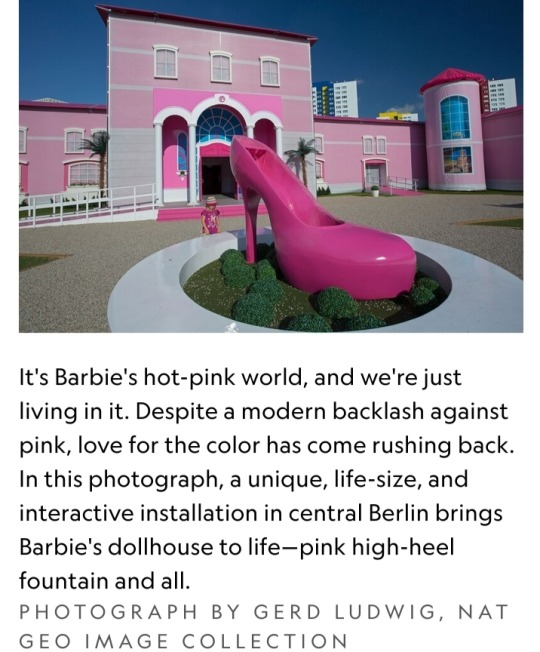
This year, Greta Gerwig’s upcoming Barbie movie helped fuel the rise of the pink-drenched “Barbiecore” aesthetic, inspiring admirers to saturate their homes and wardrobes with every shade of pink.
According to Axios, searches for the term “Barbiecore aesthetic room” rose over 1,000 percent between May 2022 and May 2023, reflecting consumers’ craving for as-pink-as-possible interiors.
There’s no telling which permutation of pink will captivate us next — but given the colorful history of the hues that fall somewhere between white and red, pink’s next heyday is probably right around the corner.

Barbie would approve of the pink petals on this beach morning glory.
Pink flowers like this one get their rosy tinge from a group of biological pigments called anthocyanins, which attract pollinators — and human admirers — to colors ranging from the palest carnation to the most ostentatious tropical fuchsia.
#pink#red ochre#carmine#Era of Exploration#Madame de Pompadour#Louis XV of France#mauve#Elsa Schiaparelli#gender#baby fashion#colors#Helen B. Andelin#AIDS Coalition to Unleash Power (ACT UP)#Pantone#Millennial Pink#Barbie#Nat Geo#fashion#political movement#Marilyn Monroe#Zsa Zsa Gabor#pigment
14 notes
·
View notes
Text

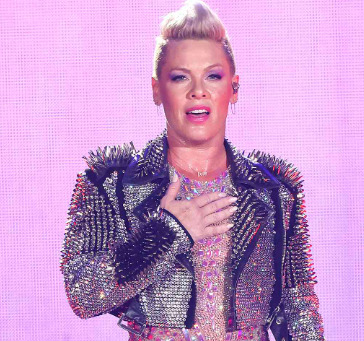


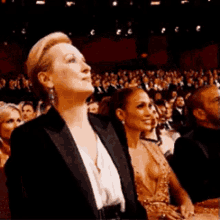
One pop star never afraid to do something worthwhile!
#pink#florida news#ron desantis#ron desatan#politics#political movement#book banning#pop culture#celebrity activism#activism
2 notes
·
View notes
Text

So a lot of political scandals just dropped in the last 24 hours
-NC Governor Candidate Mark Robinson's online posts were found, including some VERY graphic descriptions (like seriously, do not read if you're not 18) of him cheating on his wife, calling himself a black Nazi, and expressing support for reinstituting slavery. His email address was also found on Ashley Madison
-Robert F Kennedy Jr was revealed to be cheating on his wife with a reporter (and that isn't even the weirdest thing since federal law enforcement opened an investigation into him allegedly cutting off the head of a whale and taking it home with him less than 24 hours ago)
-GOP Senate candidate who is the CEO of a bank has been found accepting millions of dollars from what seem to allegedly be Mexican drug cartels.
-Finally, probably the biggest bombshell, according to multiple eyewitness testimonies within sealed sworn affadavits, Congressman Matt Gaetz allegedly invited a 17-year-old girl to a drug-fueld sex party
And we haven't even hit October, folks. Again, these are all still breaking news stories, so things are subject to change, but oh man oh man.
#politics cw#genuinely I think/hope this election cycle is what drives a stake through the heart of the maga movement#especially since Trump doesn't have much time left himself#edit: I messed up and had the wrong article for the whale story#just fixed it!
28K notes
·
View notes
Text


benandjerrys on Instagram
#ben and jerrys#ben and jerry's ice cream#election 2024#project 2025#black lives matter#blm movement#hope#hopecore#united states#us politics#donald trump#elon musk#gen z#positivity#happiness#climate justice#climate change#greta thunberg#save palestine#save our planet#sustainability#vegan#vegetarian#liberals#booklr#bookworm#banned books#blacklivesmatter#leftist#leftism
13K notes
·
View notes
Text
You know that Chris Fleming line that goes "Call yourself a community organizer even though you're not on speaking terms with your roommates"?
I honestly think every leftist who talks about the "revolution" like Christians talk about the rapture needs to spend a year trying to organize their workplace. Anyone who sincerely talks about building a movement so vast and all-encompassing that it overwhelms all existing power structures needs the dose of humility that comes with realizing they can't even build a movement to get people paid better at a badly run AMC Theaters where everyone already hates the manager.
#method speaks#union stuff#politics#i guess#best case scenario in this plan we get some successful union drives#worst case people realize that movement building is hard#and also explicitly mentioning socialism is counterproductive#mostly i'm just venting#it's only april how is election discourse this unhinged already?
20K notes
·
View notes
Text
Solarpunk: an artistic and political movement derived from science fiction subgenres, which arose at the beginning of the 21st century, in opposition to science fiction dystopias. Solarpunk offers an optimistic vision of a sustainable future, interconnected with nature and community, in light of the concerns of intersectional struggles. Solarpunk media often portrays themes of equality, anti-capitalism, and sustainability.



Some Solarpunk flags I made. So the idea I had with these was taking a bit of a different approach than the more common Solarpunk flags which tend to be anarchist style half-and-half.
The first was inspired by this commonly used Solarpunk flag, keeping the same general colors and symbol, but I wanted to lighten it up a bit to match the more optimistic beat of the movement. So I added the yellowish off-white color for that, but maintaining the black and green which obviously harkens to a lot of the Communalist and/or Green Anarchist roots of the movement.
The second was just trying to really lean on that bright utopian energy so decided to go with the very ecological green and yellow mix, while also keeping the light color from the first. It was also partially inspired by this flag I saw. I added the green boarder to the logo on that one as the yellow and white blended a lot.
The third was just a color combo suggested by a friend that I liked a lot and still had a very ecological vibe to it.
You can find larger file sizes for these here (be sure to download from desktop), but if you need a larger for any reason feel free to send me a message. These designs are completely free for anyone to use in anyway they wish so go wild.
#solar punk#solarpunk#social ecology#communalism#ecosocialism#ecology#enviromentalism#green anarchy#green anarchism#anarchy#anarchism#anarchist#socialist#socialism#vegan#veganism#vegetarian#redesign#recolor#political movement
122 notes
·
View notes
Text

Every accusation is a confession.
#donald trump#trump supporters#maga#republicans#politics#right wing#right wing extremism#right wing bullshit#gop#gop hypocrisy#us politics#child abuse#conservatives#maga morons#maga movement#elon musk#jd vance#pete hegseth#patriarchy
4K notes
·
View notes
Text
The Ba'athists are best known as Saddam Hussein's murderous political movement in Iraq, but they first seized power next door in Syria in 1963.
"Why the West Rules – For Now: The patterns of history and what they reveal about the future" - Ian Morris
#book quote#why the west rules – for now#ian morris#nonfiction#ba'ath#saddam hussein#political movement#politics#iraq#syria#60s#1960s#20th century
0 notes
Text

#donald trump#maga cult#us politics#fuck maga#january 6#trump pardons#antifascist#blm movement#fbi agent
4K notes
·
View notes
Text

Title/Name: Roman Stanisław Dmowski, commonly known as ‘Roman Dmowski’, (1864–1939). Bio: Polish politician, statesman, and co-founder and chief ideologue of the National Democracy political movement. Country: Poland Wojak Series: Feels Guy (Variant) Image by:��Unknown Main Tag: Roman Dmowski Wojak
#Wojak#Roman Stanisław Dmowski#Roman Dmowski#Feels Guy#statesman#chief ideologue#National Democracy#political movement#Politics#Politician#Poland#Roman Dmowski Wojak#Feels Guy Series#White#Gray#Brown
0 notes
Text
“Rep. Al Green is back in the news as a 2021 clip of him passionately calling out GOP members for using God to oppose LGBTQIA+ rights goes viral again, reminding them how religion was historically misused to justify slavery and segregation”
(source)
#our queer experience#al green#us politics#lgbtq rights#black liberation#civil rights movement#trans rights#gop
3K notes
·
View notes
Text
I will say I get the vibe that a lot of peoples interest and support for strikers is a bit too much for a vicarious ‘burn it down’ thrill, rather than for the actual goals of a strike.
Like UPS has agreed to come back to the table and it is very possible they will concede to Union demands and avert a strike. And if that happens (so long as the union does not make concessions on its key demands) it’s a good thing. It’s a victory for the laborers. It is the same ultimate conclusion that a strike would intend to produce except without the workers having to go on (not so great) strike pay for a week or two.
#I understand to an extent bc I think such a major strike would be very politically significant for the labor movement#But UPS submitting to union demands to avert a strike also accomplishes this. Maybe in a less visible way but all the same#Also on a personal note I would love to see UPS get absolutely fucked but again: strike goals are more important here
32K notes
·
View notes